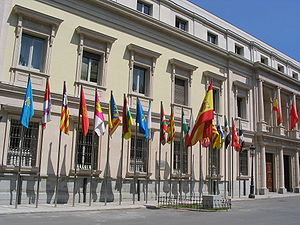Federalism in Spain

Federalism in Spain began in the 1830s, although it has its roots in the 1790s. The first and only attempt to establish a
History
19th century: the failure of the Federal Republic of 1873-1874
Starting in the 1830s, the most
In the republican newspaper El Huracán published between 1840 and 1841, it held the United States as a model of "pure democracy" and included the following federal and Iberian verses:[2]
First of all, dethrone the unfaithful race of
Isabel.
Federalism started from the medieval "old kingdoms" to define the states that would form the Spanish federal Republic. Its great theorist was the Catalan republican politician Francesc Pi i Margall author of "Las Nacionalidades" published in 1877 shortly after the failure of the federal experience of the First Spanish Republic.[3] As Juan Francisco Fuentes has pointed out, the federalists reasoned in reverse that the Frenchified and the Moderates who "made the State the cornerstone of their modernizing project, to the detriment of the sovereign nation", because they considered "the nation would only reach the fullness of its existence if the unitary and centralist State - taxes, fifths, forces of order, covachuelas, monarchy - was conveniently scrapped", thus proposing a "kind of nation without a state."[4]
The federalists' conception of Spain has been defined as a "multi-state nation that would make citizens and territories alike free", a "strange hybrid", according to
According to
Second Spanish Republic
In the Spanish Constitution of 1931, which governed the Second Spanish Republic, a territorial model was established halfway between federalism ―which was no longer defended by the republican parties due, among other reasons, to the influence of regenerationism and the failure of the federal experience of 1873-1874 ―[10] and centralism ― for example, Republican Union conceived the State as "an interaction of municipal and regional autonomies within the indestructible unity of Spain". This new formula was called the "Integral State, compatible with the autonomy of the Municipalities and Regions."[11] But it was not agreed that the autonomy regime would be for everyone by demanding a very broad support from the population ―two thirds of the electoral census― in the “regions” that demanded access to it ―in fact only Catalonia, the Basque Country and Galicia undertook the process.[12]
Transition and democratic consolidation

In the
The "
In the first decade of the 21st century, the Catalan socialist Pasqual Maragall, who advocated the concept of "differential federalism"—the center of his political thought[19]—proposed through the Statute of Autonomy of Catalonia of 2006 the fit of Catalonia in Spain within a federal model [20][21][22] inspired in a certain way by the traditionally supported "asymmetric federalism" for the peripheral nationalisms.[23]
See also
- Anarchism in Spain
- Autonomous communities of Spain
- Cantonalism
- Federalisation of the European Union
- Federal republicanism
- Glorious Revolution
References
- ^ Fuentes 2013, pp. 186–187
- ^ Fuentes 2013, p. 187
- ^ Núñez Seixas 2018, p. 34
- ^ Fuentes 2013, p. 188
- ^ Fuentes 2013, p. 187
- ^ Fuentes 2013, pp. 187–188
- ^ Fuentes 2013, pp. 188–189
- ^ De la Granja, Beramendi & Anguera 2001, p. 21
- ^ De la Granja, Beramendi & Anguera 2001, p. 22
- ^ De la Granja, Beramendi & Anguera 2001, p. 114
- ^ De la Granja, Beramendi & Anguera 2001, pp. 114–115
- ^ De la Granja, Beramendi & Anguera 2001, pp. 116–117
- ^ De la Granja, Beramendi & Anguera 2001, p. 197; 199
- ^ De la Granja, Beramendi & Anguera 2001, p. 200
- ^ Juliá 2013
- ^ Núñez Seixas 2018, pp. 133–136
- ^ De la Granja, Beramendi & Anguera 2001, p. 203
- ISSN 0188-7017. Archived from the original(PDF) on 21 October 2012.
- ^ Duarte i Montserrat 2011, pp. 321–322.
- El Pais (in Spanish). Barcelona. 27 October 2004.
- TV3 (in Catalan). Televisió de Catalunya. 25 March 2003.
- ^ "Carod lamenta que hi hagi "un cert classisme etnicista" en part del nacionalisme català i demana més catalanistes "de l'Espanyol"". El Debat (in Catalan). 23 September 2009. Archived from the original on 28 September 2009.
- ISBN 848021452X.
Bibliography
- ISBN 84-7738-918-7.
- ISBN 978-84-9836-833-8.
- ISBN 978-84-8109-997-3.
- ISBN 978-84-8109-997-3.
- ISBN 978-84-9199-027-7.
